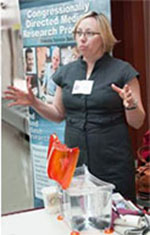NEWS RELEASE
Released: April 10, 2013
Brain Awareness Week
On March 11th, scientists from the Congressionally Directed Medical Research Programs (CDMRP) participated in the annual Brain Awareness Week sponsored by the National Museum of Health and Medicine (NMHM). The event is designed to inspire middle school students about science and medicine through hands-on activities specifically related to the brain.
The staff from the CDMRP, Drs. Naba Bora, Holly Campbell-Rosen, and Donna Kimbark presented concepts about how the brain processes sensory input, how sensory signals interact with memory signals, and how we perceive the world around us. In a hands-on demonstration, the students were able to see and test how a weakly electric fish is able to sense the world around it using the electric field it generates around its body. Perturbations of the field allow it to recognize and identify possible threats and food through a system of mapping the stimuli and environment within its brain, a function of the cerebellum. The students were able to detect the electric field of the electric fish with an electrode and a sound amplifier. They learned that the cerebellum of the fish may play a role acting as an adaptive filter of sensory inputs by comparing the incoming sensory input with expected inputs in their environment. This phenomenon, of having an expectation of what the next incoming sensory input will be, is known as corollary discharge, and is critical to how the brain makes decisions on what to focus on and what to 'subtract' as noise. Students were taught that their brains must do this adaptive filtration of their environment every day, all day.
In addition, the students were also shown how the brain could be tricked through a number of optical illusions. The students looked at these optical illusions and saw that while their brain might expect one thing, in actuality the drawing or portrait showed quite another. Visual input and brain expectation was tested as the students reviewed the illusions and discussed sensory and perception links.
The students participated in a series of 'did you know' questions about the brain such as the fact the brain is the fattiest organ in the body, and that there are no pain receptors in the brain so that some brain surgeries are done with the patient awake, helping and guiding the surgeon!
The staff of the CDMRP experienced an exciting day with the children during Brain Awareness Week and look forward to continued participation next year.
National Museum of Health and Medicine Entertains and Educates:
http://www.dcmilitary.com/article/20130322/NEWS03/130329904/brains-national-museum-of-health-and-medicine-entertains-and
National Museum of Health and Medicine Welcomes DC-Area Middle School Students
http://www.medicalmuseum.mil/index.cfm?p=media.news.article.nmhm_welcome_students_for_brain_awareness_week_2013















